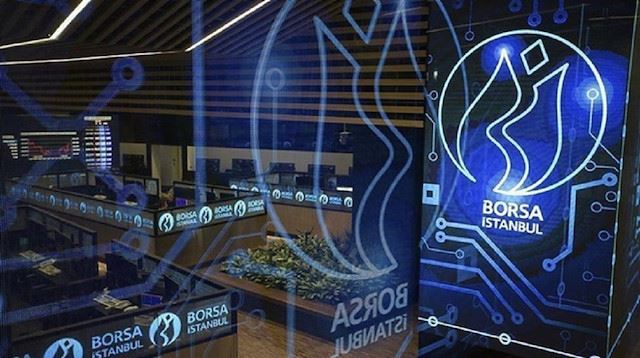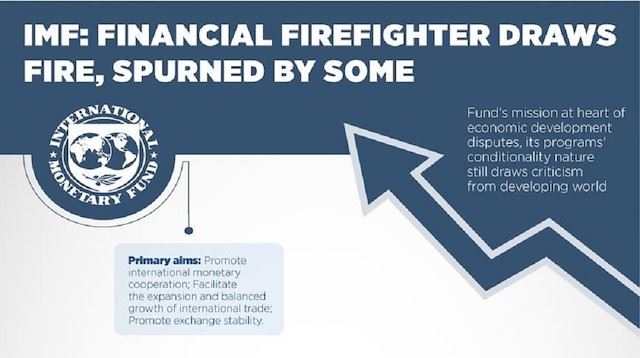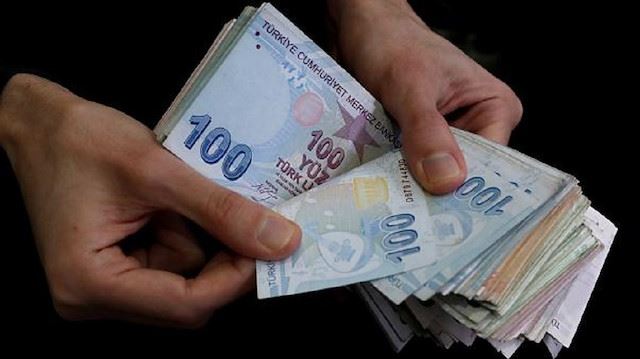The Turkish Central Bank on Thursday announced its official reserves amounted to $104.6 billion as of the end of October. Total reserve assets jumped
The Turkish Central Bank on Thursday announced its official reserves amounted to $104.6 billion as of the end of October.
Total reserve assets jumped to 3.4% in October, versus the end of September, the bank’s international reserves and foreign currency liquidity report showed.
Foreign currency reserves — in convertible foreign currencies — totaled some $76.5 billion, up 3.8% compared to the previous month.
In October, the bank’s gold reserves — including gold deposits and, if appropriate, gold swapped — also rose 2.7% monthly to $26.6 billion.
In mid-December 2013, its total reserves hit their all-time peak at nearly $136 billion, including some $21 billion in gold reserves.
Turkey’s economic confidence index at 91.3 in November
Turkey’s economic confidence index rose to 91.3 in November on a monthly basis, according to official data released on Thursday.The figure rose 1.7% from 89.8 in October, the Turkish Statistical Authority (TurkStat) said.Improvement in consumer, real sector and services sector confidence indices led to the rise in economic confidence, it added.”Consumer, real sector and services confidence indices increased to 59.9, 105.9 and 91.3 respectively in November,” TurkStat noted.It also said retail trade and construction confidence indices dropped to 101.2 and 63.9 respectively in the month.The economic confidence index is a composite index that encapsulates consumers’ and producers’ evaluations, expectations, and tendencies about the general economic situation, according to TurkStat.A total of 20 sub-indices are used in the calculation, with data collected in the first two weeks of each month.A value above 100 shows an optimistic outlook for the general economic situation, while a value below 100, a pessimistic outlook.In 2018, the index saw its highest value in January at 105.2 points, as the lowest figure was recorded at 75.2 points in November.

Turkey’s Borsa Istanbul up at Thursday opening
Turkey’s benchmark stock index started Thursday at 106,084.66 points with a daily rise of 0.21%, or 240.49 points.On Wednesday, Borsa Istanbul’s BIST 100 index slipped by 0.13% to close the day at 105,844.17 points with a daily trading volume of 8.6 billion Turkish liras (some $1.49billion).The U.S. dollar/Turkish lira exchange rate stood at 5.7770 as of 9.30 a.m. local time (0630GMT) on Thursday, compared to 5.7780 at Wednesday’s close.The euro/Turkish lira exchange rate stood at 6.3660, versus 6.3560, and one British pound traded for 7.4970 Turkish liras, versus 7.4480 at the previous close.One barrel of Brent crude oil sold for around $62.82 as of 10 a.m. local time (0700GMT).

IMF: Financial firefighter draws fire, spurned by some
While standing at the forefront of global economic crisis management, the International Monetary Fund is a frequent target of criticism for its attempts to foster financial stability.The IMF’s issues started at its birth, in July 1944 in Bretton Woods, New Hampshire, in the U.S., when industrial economies were in charge of shaping the postwar international monetary system, and economic development was not their primary concern.The “Bretton Woods baby” was established for the purpose of developing international competition and boosting trade following World War II, and was seen as the central bank for a new era of international trade.The IMF’s founding fathers focused on the enlargement of trade and investment, believing this would be the best way to foster economic prosperity for all countries, including developing ones.The lifting of extensive restrictions on trade and payments, enabling convertibility among currencies, and retaining stability in exchange rates, were considered milestones in this trade expansion. Over time, developed countries, especially the U.S., did not want to give the right of seigniorage (profit from currency, in short) to an international organization, leading the Fund to become a body that changed its aim from fostering global trade to intervening in foreign debts, growth, and the stability problems of less-developed countries.- CriticsSince then, the IMF has been considered an instrument of the hegemony of money.For many, the institution’s main function was seen as boosting developing countries’ dependence on American policies that guarantee the free movement of capital and profit worldwide.”The structural reforms proposed by the IMF to developing countries during crisis periods in the less-developed world further deepened catastrophes,” said Erinc Yeldan, the head of the Economics Faculty at Bilkent University in Ankara, Turkey’s capital.He said that the Fund’s comprehensive structural conditions — especially for countries facing a liquidity crisis — led international investors to make false and exaggerated assessments of the depth of the crisis.Many also argue that its approach in tackling economic problems facing developing countries was based heavily on the implementation of best-practice models that failed to take into account the complications of other settings. As Dani Rodrik, a distinguished Turkish-born economist at Harvard University, once said:”Developing nations are different from advanced ones in that they face both greater challenges and more constraints.”The IMF’s role has also been criticized on several fronts, with Yeldan in particular citing the 1997 Asian economic crisis, saying the Fund’s financial intervention then was misguided and one-sided.He said the IMF had ignored the structural differences among countries by giving the same prescriptions to every failing country that knocked on its door.- Blueprints for Latin America and Asia In the 1980s, Latin American countries reached a point where their foreign debt exceeded their earning power, and inflation was quite high. The IMF’s medicine for these problems was the implementation of fiscal austerity and tighter monetary policies, a precondition for its financial support. Yet in 1997, when the IMF called for the same demands for Thailand, this was considered a mistake. Unlike Latin American countries, East Asian countries were already running budget surpluses and tight monetary policies, according to Joseph Stiglitz, the well-known Nobel Laureate in economics.Although the Far East did not suffer from the same economic woes, its countries were offered the same cure by the IMF.”The problem was not imprudent government, as in Latin America; the problem was an imprudent private sector — all those bankers and borrowers, for instance, who’d gambled on the real estate bubble,” Stiglitz once said.- Pointed questionsAfter these painful experiences, some questions were raised about the body’s reform packages:Does the “conditional” nature of IMF programs reduce the flexibility of leaders and sabotage democratic accountability?Do democratic leaders “scapegoat” the Fund to legislate policies that might be politically unattainable otherwise?Or are they truly powerless to battle against IMF-imposed policies?It seems academics are still looking for answers to these questions and trying to figure out what affects a country’s bargaining leverage vis-à-vis the IMF.According to Stiglitz, the IMF likes to go about its business without outsiders asking too many questions.”In theory, the fund supports democratic institutions in the nations it assists. In practice, it undermines the democratic process by imposing policies,” he said in a 2000 interview.The words of Paul Krugman, another Nobel Laureate economist, lay out the point of view of many countries towards the IMF:”No one loves the IMF. If someone loved it, that would be a bad sign. Since the IMF is the final decision-making authority, governments only go to this institution when they get into trouble, and the last thing you expect from the last resort institution is mercy.”- Could the IMF be more pragmatic?In the aftermath of the 2007-2008 global financial crises, the role of government in the economy grew, with the implementation of Keynesian policies such as government spending on infrastructure, unemployment benefits, and education.In 2010, the world’s controversial financial firefighter regained prominence with the emergence of the European sovereign debt crisis.Until that time, much of the Fund’s money was sent to developing countries such as Argentina, Brazil, and Indonesia.Yet the European debt crisis for the first time required major bailouts in advanced eurozone economies, including Greece, Iceland, Ireland, and Portugal.”The European turmoil made it obvious that the IMF’s attitude toward Europe’s developed countries was not as hard as it was on less-developed ones,” stressed Yeldan.He voiced another common criticism of the IMF, saying that these advanced economies also enjoyed IMF financial support from time to time yet without imposing the Fund’s structural straitjackets.Unable to remain indifferent to these criticisms, the IMF has recently made a series of reforms to lending conditions to low-income countries, focusing on country-specific tailoring and an “emphasis on poverty alleviation.”Also, the IMF’s latest review of conditionality, finished in 2018, aimed to improve transparency and assess IMF programs in a timelier manner.According to Yeldan, under Bulgaria’s Kristalina Georgieva, the IMF’s new five-year term president as of Oct. 1, from an emerging market, the Fund is expected to be more pragmatic, taking into account the different fundamentals of countries and functioning as an advisory board.- AlternativesDespite the IMF’s efforts to boost its credibility, some countries prefer knocking on the doors of other countries or writing their own prescriptions instead of asking the Fund for help. Pakistan for example, in 2018 looked for Chinese and Saudi loans before going to the IMF.Turkey can also be cited as a good example, since it shows why developing countries’ real-world reformers sometimes try to steer clear of IMF reform packages.Despite being the Fund’s most dedicated client over the past few decades under IMF-assisted programs, Turkey saw three notable financial crises along the way, in 1994, 2000, and 2001.Some academics and politicians in the country considered IMF bailouts a crisis-ridden path and have been skeptical of IMF structural reform packages.In 2009, when the global financial crisis broke out, for instance, Turkey declared that it could weather the storm without IMF help and “move forward without a crutch.”And indeed it did; the country got over the crisis without looking for IMF support, and in 2013 moved to clear its remaining $864 million debt with the Fund.Since then the government has made it repeatedly clear that the days of it going to the IMF cap in hand were gone for good.
